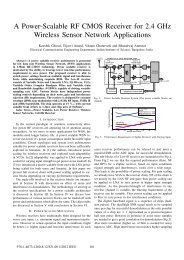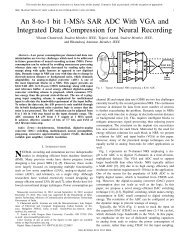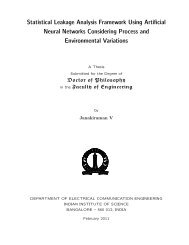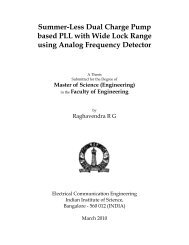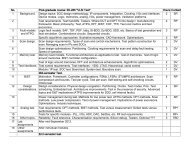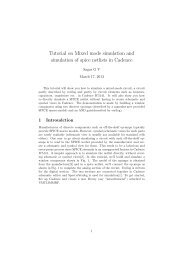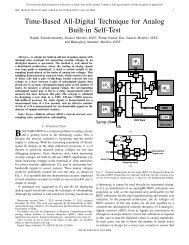NoC design and optimization for Multi-core media processors
NoC design and optimization for Multi-core media processors
NoC design and optimization for Multi-core media processors
You also want an ePaper? Increase the reach of your titles
YUMPU automatically turns print PDFs into web optimized ePapers that Google loves.
CHAPTER 2. RELATED WORK 13switches interconnects 12 IPs supports both bursty (<strong>for</strong> image traffic) <strong>and</strong> non-bursty (<strong>for</strong>control <strong>and</strong> synchronization signals) traffic. Network resources in this <strong>NoC</strong> are tailoredto meet throughput <strong>and</strong> b<strong>and</strong>width dem<strong>and</strong>s of the application <strong>and</strong> hence the <strong>design</strong> isnot a generic solution <strong>for</strong> servicing QoS in an CMP environment.2.1.2 QoS in Circuit Switched NetworksResource reservation between communicating nodes involves identification of path usingpoint-to-point links or a path probing service network or an intelligent, traffic awaredistributed or centralized manager. Hu et. al.[15] introduce point-to-point (P2P) communicationsynthesistomeettimingdem<strong>and</strong>sbetweencommunicatingnodesusingbuswidthsynthesis. Circuit switched bus based QoS solutions such as Crossroad[13], dTDMA[14]<strong>and</strong> Heterogeneous IP Block Interconnection (HIBI)[32] rely on communication localizationto satisfy timing dem<strong>and</strong>s. NEXUS[39] is a resource reservation based QoS <strong>NoC</strong><strong>for</strong> globally asynchronous, locally synchronous (GALS) architectures. NEXUS uses anasynchronous crossbar to connect synchronous modules through asynchronous channels<strong>and</strong> clock-domain converters.P2P networks do not share communication links between multiple nodes leading toinefficient utilization of network resources. This increases wiring resources inside thechip <strong>and</strong> results in poor scalability. Crossbar based solutions using protocol h<strong>and</strong>shakes(<strong>for</strong> example, 4-way h<strong>and</strong>shakes in NEXUS[39] <strong>and</strong> Proto<strong>NoC</strong>[17]) <strong>for</strong>ce communicatingnodes to wait till h<strong>and</strong>shake is complete <strong>and</strong> path is established. Non-interference ofcommunication channels is achieved by over-provisioning resources in the crossbar. Thisleads to complex <strong>and</strong> poorly scalable networks. Connecting frequently communicatingnodes on a single bus will increase dem<strong>and</strong> on the bus <strong>and</strong> lead to larger waiting times atthe nodes. Static routing along shortest paths does not guarantee latency bound routesdue to arbitration delays in the network.Amongst the <strong>NoC</strong>s that use a probe based circuit establishment solutions are Intel’s8×8 circuit switched <strong>NoC</strong>[41], SoCBUS[19][55] <strong>and</strong> distributed programming model in




